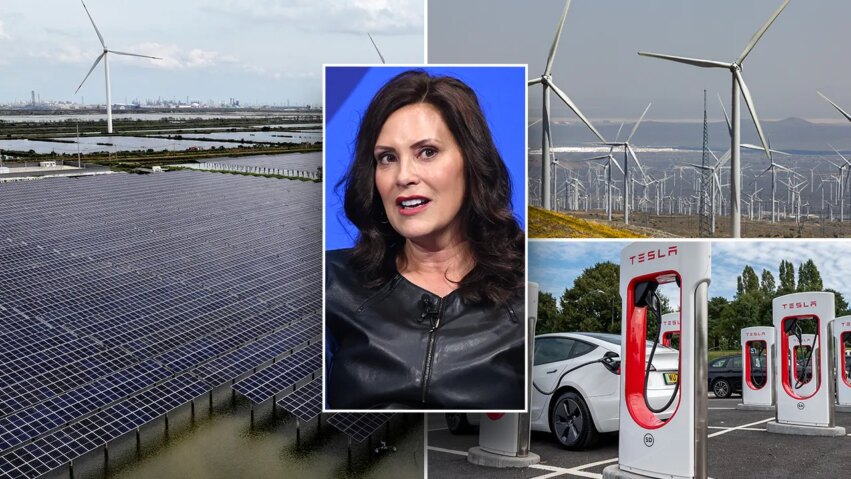Liberal media props up Gov. Gretchen Whitmer for 2024 Former presidential candidate Mike Huckabee joins ‘Fox & Friends First’ to discuss the possibility of a presidential run by Michigan Gov. Gretchen Whitmer and the calls for his daughter, Gov. Sarah Sanders, to remove the cross outside her home. Democratic Michigan Gov. Gretchen Whitmer signed a landmark legislative package that requires state power providers to meet some of the most aggressive green energy goals in the country.Whitmer was joined by fellow state Democrats, climate activists and industry stakeholders during a ceremony Tuesday where she signed the seven green energy bills that aim to reduce Michigan’s reliance on fossil fuels and improve environmental quality statewide. The topline target mandated under the so-called Clean Energy Future plan is a 100% clean energy standard that must be met within two decades.”Once I sign these bills, Michigan becomes a national leader on clean energy, bringing billions of federal tax dollars home and private investment into our communities,” Whitmer remarked before signing the legislation. “Together, we are protecting our air, our water and our land while focusing on taking climate change head on. Today is a huge win for Michigan families, for Michigan businesses, and for future generations of Michiganders.””Our clean energy future is ambitious, but it is achievable,” she continued. “I have no doubt that, if we pursue this wholeheartedly, we can get it done because, in Michigan, we’re not afraid of hard things. We have defied and defined history so many times before, and I know we are up to it again. We will lead the clean energy future because we have the workforce, and now the legislation, to foster strong economic growth.”CALIFORNIA’S GRID FACES COLLAPSE AS LEADERS PUSH RENEWABLES, ELECTRIC VEHICLES, EXPERTS SAY Gov. Gretchen Whitmer said Tuesday that the legislation makes Michigan “a national leader on clean energy.” (AP Photo/Alex Brandon, File)Senate Bill 271, one of the bills included in the package, establishes a renewable energy standard of 50% by 2030 and 60% by 2035, meaning electric utilities meet at least that share of their electric generation capacity with renewable energy credits or direct renewable energy generation. That mandate supersedes previous laws requiring utilities to achieve a 15% renewable energy standard through 2029.In addition, under the bill, utility providers must meet an 80% clean energy standard by 2035 and a 100% clean energy standard set to be achieved by 2040. The clean energy standard would include natural gas-fired generation with 90% carbon capture, a nascent and expensive technology that hasn’t been deployed at any power plant nationwide.TEXAS VOTERS OVERWHELMINGLY APPROVE MEASURE GREENLIGHTING MORE FOSSIL FUEL DEVELOPMENTAnd the Michigan Clean Energy Future plan transfers permitting authority for large-scale green energy projects from local control to Michigan Public Service Commission, the state regulator. The move would ensure such projects move forward over widespread local opposition.The Michigan state Senate ultimately approved the package late last month and the state House of Representatives subsequently passed it earlier this month. The legislation was passed by slim majorities in both chambers, which are both simultaneously under Democratic control for the first time since the 1980s.”Let’s face it, Gov. Whitmer is trying to build her national profile with the Democrat Party,” Michigan House Republican Leader Matt Hall told Fox News Digital in an interview. “I think in order for her to build her brand with the far left and the Democrat Party, she felt she had to try to one up them here in Michigan.” A wind farm is pictured outside Traverse City, Michigan. Solar and wind power collectively produce just 8.1% of the state’s electricity. (Elizabeth W. Kearley/Getty Images)He noted that Whitmer originally proposed a ban on natural gas and full renewable energy standard by 2035, a proposal that was ultimately watered down in the bills she signed Tuesday.”There is no fuel source that we have that’s as clean and efficient, reliable and affordable as natural gas,” Hall continued. “When you’re replacing that artificially with other sources of energy that are just not as efficient, they take huge capital costs and you have to build a lot more of them to get the same power, that cost gets passed on to the ratepayers of the state, which are manufacturers, they’re small businesses and they’re individuals. They’re going to see their energy bills go up.”DEM GOVERNOR WITHDRAWS ELECTRIC VEHICLE MANDATE IN STUNNING BLOW TO ENVIRONMENTALISTSUnder the Clean Energy Future plan, the average monthly electric bill would be nearly double the current average in coming decades, according to a recent report from the Mackinac Center for Public Policy, a free market think tank which analyzed the package of energy bills. The report further warns that overall grid reliability would be severely diminished under the plan.”The biggest thing is prices are going to go up, reliability is going to go way down and people are going to be left sitting in the cold in Michigan in January, like our modeling shows, for as much as 61 hours without electric service because of these plans,” Jason Hayes, the Mackinac Center’s director of energy and environmental policy and one of the report’s authors, previously told Fox News Digital.”Where if we decided to do it with reliable sources of energy like fossil fuels, we could do it for far less and avoid those outages, avoid the blackouts. So, to me, it seems a no-brainer. We should be doing it for less money and more reliability,” he continued. The closed DTE Energy River Rouge coal-fired power plant in River Rouge, Michigan, on April 19, 2022. DTE Energy retired the plant in 2021 as part of the energy company’s “clean energy transformation.” (Erin Kirkland/Bloomberg via Getty Images)Hayes added that the intermittent nature of solar and wind, meaning they produce less power relative to their total generation capacity, could create instability. Green energy developers and government officials often highlight total capacity of new renewable power projects, but fail to mention how much actual power the project is expected to produce.Solar panels, for example, produce just 25% and wind turbines produce 34% of their listed capacity, according to federal data. Coal, natural gas and nuclear power plants, meanwhile, produce 49%, 54% and 93% of their listed capacity, respectively.CLICK HERE TO GET THE FOX NEWS APPMeanwhile, according to Energy Information Administration data reviewed by Fox News Digital, Michigan routinely ranks among the top five states in residential use of natural gas and in the top 10 for total natural gas consumption. More than 75% of Michigan residents rely on natural gas as their primary source for home heating.Natural gas-fired power plants produce by far the largest share of the state’s electricity, the most recent data showed, followed by nuclear energy and coal-fired power. By comparison, solar and wind power collectively produce just 8.1% of the state’s electricity. Thomas Catenacci is a politics writer for Fox News Digital.





















